Gluten-removed. Gluten-friendly. Gluten-conscious. All ridiculous terms made up by lazy companies that want to cash in on the gluten-free market without going the extra mile to keep those who can’t have any gluten from getting ill.
But “gluten-free” is supposed to mean something. If something is labeled gluten-free, it should mean that it is safe for the celiac and NCGS community, with as little risk as humanly possible.
Here’s how the FDA defines gluten-free, as of new labeling laws put in place in 2014.
In general, foods may be labeled “gluten-free” if they meet the definition and otherwise comply with the final rule’s requirements. More specifically, the final rule defines “gluten-free” as meaning that the food either is inherently gluten free; or does not contain an ingredient that is:
- a gluten-containing grain (e.g., spelt wheat);
- derived from a gluten-containing grain that has not been processed to remove gluten (e.g., wheat flour); or
- derived from a gluten-containing grain that has been processed to remove gluten (e.g., wheat starch), if the use of that ingredient results in the presence of 20 parts per million (ppm) or more gluten in the food.
Also, any unavoidable presence of gluten in the food must be less than 20 ppm.
Is it me or did you have to read that a few times to fully understand it? Actually…don’t answer that. Or if you do, use one syllable words and very short sentences so I can comprehend it.
When Mrs. Dude or I go shopping, if it’s a new item we are picking up, the first thing we look for is the “gluten-free” label. And 9 out of 10 times, it means the product is safe and I breathe a sigh of relief. But then I’ll look at the back of the package and if it says it was made in a shared facility or shared equipment with gluten, I breathe a sigh of disappointment and it goes back on the shelf. It doesn’t necessarily mean the item wasn’t safe, but in my eyes it means there is more of a risk than I’m willing to take.
Now the frustrating part is adding “made in a facility (or shared equipment) that also processes gluten” to a product is completely voluntary. And the companies will always say they use best practices to minimize the risk. And I’m sure many do. But how do you know which ones cut corners?
Case in point: A few years back, I had quite an interesting back and forth with Bart’s Cookies after I claimed their gluten-free cookies should not be labeled gluten-free because the packaging says “may contain wheat” and the shared equipment looks like this after making a batch of non gluten-free cookies:
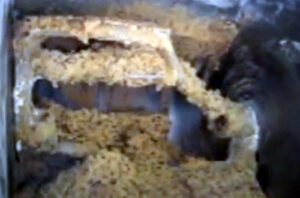
After Gluten-Free Watchdog got involved and tested their gluten-free cookies, the results showed they were over 500ppm, while Bart himself claimed the cookies were tested and were only 5.6ppm. Who are you going to believe? Oh…and after all of this, he then started telling people “If gluten is a serious health issue, I would not not chance our cookies.” No…he seriously said that and yet, his cookies are STILL labeled gluten-free.
What if we had a “Celiac Safe” label instead?
We’d need a different word than “safe” simply because it would “guarantee” them to be safe and there are no guarantees in life (and it’s a lawsuit waiting to happen). But until we can come up with a better word, let’s use “celiac safe” for now. So what would a “celiac safe” label on a package mean? Here are my thoughts (and thanks to a fellow celiac named Matthew who got me thinking about this):
- The product is made in a completely gluten-free facility.
- All ingredients used in the product that are processed in other facilities are made in a completely gluten-free facility.
- Regularly batch testing is mandatory and all batches must test below 10ppm. (I know 20ppm is legal and I’m not arguing against it, but I’d like to make “celiac safe” a bit more stringent.)
If the above steps were followed and the product was labeled “celiac safe”, I wouldn’t think twice about buying it. And how cool would that be?
Food without worrying. What a concept!


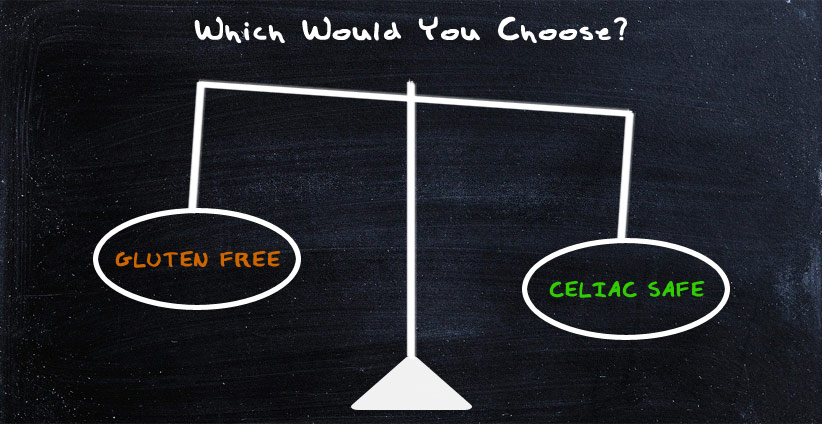
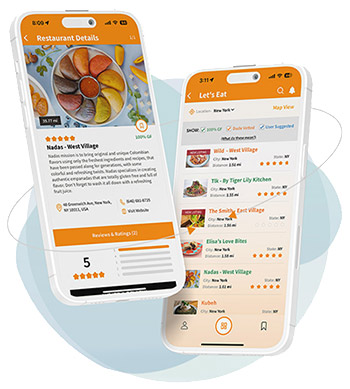
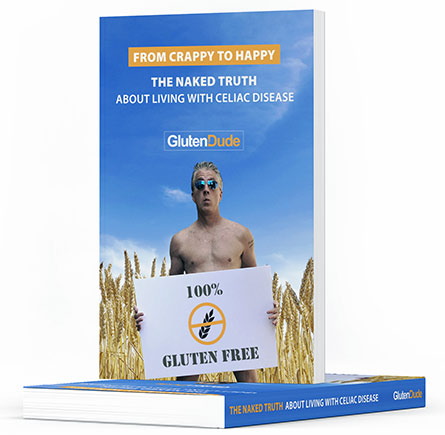
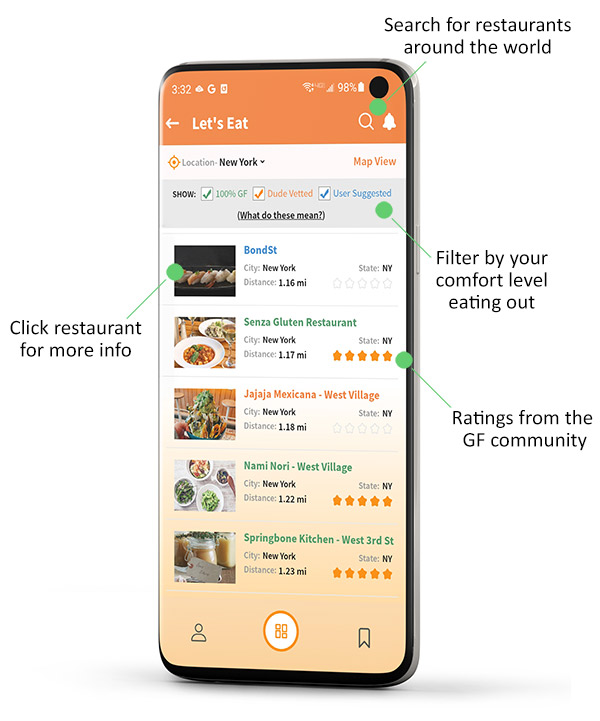



For me, I’m making the choice for my two daughters. I’m exactly like you if it’s made in a facility or on shared equipment it’s just not worth the risk. If you have celiac disease you should definitely error on the side of caution right? We rarely eat out, I bake almost everything that we have to eat instead of buying it in the store. And other things that my children eat are guaranteed gluten-free like bananas, blackberries, apples, you get the point.
I also think a celiac safe label would be awesome. But….could we trust it? Even if there were strict guidelines, that doesn’t mean that manufactures wouldn’t try and fudge on the label. At least until they get caught, which isn’t unheard of.
Yeah…no doubt some companies would still lie. Profits over people. That’s how it works here.
Your a great mom, Melissa. Keep up the diligence so your daughters are healthy and safe.
Like you I also make almost everything I eat, it is the best way I have found to be able to afford living without gluten. The Gluten Free products cannot be trusted and the markup on the product makes you think they use gold as the replacer for the gluten.
Gluten Free = $$$$
Processed in a facility that also process… and processed on equipment that was also used for… statements are both voluntary. Meaning something that was processed in a facility that also contains wheat could be labeled gluten free and also fail to say that it was made in a facility that also processes gluten. The gluten free statement is supposed to trump voluntary statements.
Correct. My point is celiac safe would make it mandatory they couldn’t produce in same facility.
In my opinion, gluten free and celiac safe should be the same thing. If a food is not celiac safe, it isn’t GF. There should be a certification process in place for packaged foods claiming to be GF.
I am very fortunate to live in Canada, where our food labelling laws are very clear. Thanks to the Canadian Celiac Association, it is easy to determine whether a food item is safe or not. CCa has a gluten free certification program, and is now also working with restaurants to ensure food safety in that industry. You can visit their site here: http://www.celiac.ca/
I agree Cari. Can you send us all some safe food to the U.S.?!
I’m sorry it is so challenging for you, Randi. It is one of the things that has kept me from travelling to the US. I’ve always lived in southern Ontario, and used to love crossing the border to shop.
BTW, I love that Frito Lay has a web page, clearly identifying their GF products. Would love to see more companies offering this!
In USA: http://www.fritolay.com/nutrition/special-dietary-needs/us-gluten-free-products-and-products-not-containing-gluten-ingredients.htm
In Canada: http://www.fritolay.com/nutrition/special-dietary-needs-canadian-lists/canadian-gluten-free-products-and-products-not-containing-gluten-ingredients.htm
Thank you for the link!
I discovered a few months ago that apparently I was getting glutened by Frito Flavor Twists. The label didn’t say gluten free or otherwise, but ingredients looked okay. There was no warning about processing facility. I have been wondering for awhile if something else had done it, but elimination seemed to lead to the Twists. Unfortunately, when I get glutened, it takes a day or so for symptoms to start, and then about 8 days for them to go away, so it is hard to pin things down.
The US list above puts Twosts in the “no gluten containing ingredients” but [contaminated equipment].
That matches my experience.
I would prefer celiac safe just so they couldn’t play those games about being produced in the same facility as wheat. I am at the point where I trust very few companies.
I would love a label that says something is safe to eat. What would it take for Celiacs Disease to be recognized as important as a peanut allergy or diabetes? I may not need an epipen when glutenized, but I sure wish there was one. So if anyone has any ideas on how to get the ball rolling, I’m in. Until then, after being diagnosed in 2003, I’m finally keeping a food diary. Finally. I have a safe list (stuff I ate that day and didn’t get sick), and a questionable list (I ate it that day and got sick). Does anyone have a method that has worked for them? I’m about to eat nothing but Whole30 forever.
Thanks Gluten Dude and Dudette!
With three young adult children who have had Celiac Disease for 14 years this issue has been the hardest for all of us. I LOVE the idea of celiac safe labeling. It would make our lives so much simpler–especially if restaurants and drug manufacturers also adopted this labeling. We are all so tired of studying labels until our eyes cross looking to make sure their labeling is accurate or questioning restaurant staff or calling drug companies trying to sort fact from fiction. We also would like to be able to go out to a restaurant safely (luckily we have one in our town that is 100% GF where we go for all family celebrations so not too much whining there). However, traveling or getting sick are challenging and it would be great to not have to work so hard all the time. Peace of mind would be a blessing!
I feel your pain Sheila. Not to mention how much more expensive it can be to stay safe. I sometimes opt out on a trip because I get tired of eating emergency GF food. Keep supporting your kids. I bet they really appreciate it!
I would like a “celiac safe” label. However, I think one of two things would happen: most companies wouldn’t want to use it because they like to use the “no guarantees” excuse to CYA; and/or we still couldn’t trust companies to be honest.
I think the GF labeling with under 20ppm is fine. I think the may contain wheat is for people with a wheat allergy. But – it still needs to be below 20ppm gluten. If companies don’t follow this – the FDA needs to crack down on them. I think Gluten Free Watch Dog just published an article saying that virtually all companies are doing a great job. I think not many companies would see the market benefit of a Celiac label and then with the gf label would be like playing roulette. The FDA needs to crack down on restaurants. Some restaurants are getting away with too much while others are doing a fantastic job. To say GF in a restaurant- there needs to be a standard that is adhered to.
Laura,
I 100% agree with this statement!! If a restaurant is not Celiac safe, they are not gluten free. Period. What part of this is not understood? The whole purpose of having GF food is so the Celiac community can go out and eat safely. Right? It angers me to no end that restaurants are legally allowed to use the GF menu when many are not.
Who’s going to start a petition!?! Lets get organized!!! How can we do this and make it stick?
For now, it is the Whole 30 for this one (unless it comes from Canada:)
Labeling laws aren’t primarily for consumer protection, that’s long established, so companies won’t do away with the GF labels anytime soon BUT the Celiac-safe label is ideal and I’m have NCGS.
The Gluten-Free Certification Organization (GFCO), who’s responsible for the GF logo with the circle around it in the USA, has a standard of ongoing testing and 10ppm on finished products for its companies. If they made a top-tier certification for those companies with GF facilities, then this safe eating dream could be a reality.
I trust the GFCO logo the most. However, even with their stringent policies they do certify OATS (gorwing, harvesting, and production taken into account) and wheat starch (gluten removed). This is my only qualm with their procedures because I have a wheat allergy and I don’t trust any Oats in between here and Pluto!
Does anyone have negative experiences or qualms with this type of solution?
Yes. GFCO validates the FDA’s inadequate rules. I don’t pay attention to GFCO anymore, not since 2014 when they opened the flood gates to their certification program. Everything went downhill fast.
Oh goodness.What happened in 2014?!?!
🙁 This is why I need to stay in touch versus checking in to GF groups.
I’m scared to find out because it’s probably why I’ve been sick all of 2017 since I went back to eating packaged goods.
Hi Lena,
Like many, I do not trust any foods made in the USA and have gone to eating only eating organic whole foods. If I have a treat it is usually a banana or blueberries with gf nuts. It was hard at first, but I feel SO much better so it is worth it.
Even with WF, there have been times that I gotten itchy blistery elbow from broccoli and wonder if it was grown near a field with wheat, rye, or barley, so even whole foods could be an issue for the very sensitive.
Thankfully I have a garden and can eat without worry most of the time.
I was just going to ask your thoughts on the Certified Gluten Free label. That’s the first thing I look for. And when I see mainstream brands with their “gluten free” label I run away. Don’t trust them regardless of what the label says. Big companies like that are going to make everything in the same facility. I like supporting the smaller companies I can trust.
Many small companies have been bought out but you would never know it by the label. The U.S. is governed by corporations with the highest bribes. Just saying, you might want to check your small company ownership before trusting the small company label.
GFCO was my go-to before 2014 and the FDA rules. GFCO then seemed to align themselves with the unhelpful FDA rules. This made GFCO meaningless for me.
I’m wondering if it would be possible to energize the market share that Celiac/NCGS wield so our voices, our purchasing power drowns out the jokes, the fad dieters and “sort of gluten free” eaters that seem to be catered to on every grocery shelf stocked with questionable gluten free food products. Would it be possible to have the tides turned in our favor so that companies manufacturing gluten free foods would do everything they could to have their 10ppm or less product listed on the “Celiac Safe” list. A coveted place, a place of honor and prestige for their product to be listed. A product that was very profitable because it was included on the Celiac Safe listing. As of now, if people continue to eat the questionable products, our bodies are at their mercy. I’d like to see our buying power change that scenario!
Love love this idea Mary! Make our voices heard!
I applaud you use of “completely gluten-free facility” because that language relates to process controls, and process controls, rather than testing, are what keep us safe.
Think of it this way: tests are only valuable if they have a predictive value, e.g., testing one box of cereal will give a high degree of confidence in a different box of the same cereal. Process controls are what makes different boxes have the same contents. Process controls are what makes each box free of gluten. Process controls make testing useful.
But “completely gluten-free facility” is not a complete list of the necessary process controls. For the concept to get traction, a complete list should be developed….then of course, the certification process needs to happen, and someone has to oversee it all.
But that’s all details. As a concept, your idea rocks.
For processed food.
For restaurants, not so much. Many restaurants have far fewer process controls than manufacturing plants. Thus, a test of one plate of food in a randomly chosen restaurant may say very little about the next plate of food. That’s why Gluten Free Watchdog won’t be helpful in testing restaurant food. The best we can do today is test a sample of each plate. Better than nothing, but far less than what can be done in a food manufacturing plant.
What should be done to extent your idea to restaurants?
I totally agree with every comment. I was diagnosed with Celiac a year ago and wow, labeling totally sucks. I have people say ” there are so many products out there that are gluten free and stores even have a gluten free section” I gave up responding with my opinion of labeling. I still cannot understand 20ppm is given a gluten free label, let alone so including processed in facility that also processes wheat . Hopefully things will continue to change.
Our current tests are not identical to how the body recognizes gluten, and they fail under common conditions like testing fermented foods. GFCO and FDA rules aren’t “Celiac Safe.” I’d argue we are much worse off than we were before 2014 because we have a false sense of security. I only buy from dedicated facilities, and this is by far the best thing a manufacturer can put on their label to win my money.
Also, no xanthan! I’m trying heal my body, not evict all my food at once.
For a month now I’ve followed gluten dude’s advice and only eaten naturally gluten free foods. No gluten free bread and other junk like that. And I feel awesome! As long as I have wine and chocolate I’m good.
Hi Katie, I learned to make some awesome dark chocolates at home you may want to try.
http://allrecipes.com/recipe/236212/homemade-melt-in-your-mouth-dark-chocolate-paleo/
I put pecan pieces. They are awesome!
Thanks! I’ll definitely try those.
What I love the most about the CD community is the amazing intelligence of everyone here!!!
On a side note, I have a question. I am cleaning out a friends cupboards so she can have a gf kitchen. What is the best procedure to clean it all? Is soap and water sufficient or should I be using bleach or an acid wash of some kind?
Thanks everyone!
Soap and water for every thing. If she used a lot of flour in baking or cooking, that means it has been airborne and covered every surface in the kitchen. Cleaning all surfaces, appliances, etc. would be needed. Make sure all the drawers are cleaned because, as we all know, while busy in the kitchen with drawers being pulled open, crumbs will fall! Old baking pans and cookware can have years of gluten filled residue on them. That residue can be scratched off with removal of the new GF baked items. And many people have had problems when gluten leached out of the scratches in their cookware. I, personally, only had a few baking/cooking items I had to let go of to keep myself safe. Each person’s story will be different because of their level of intolerance to gluten. Hope this short reply will help you get started. Thanks for being such a sweet friend to take on a such a huge “labor of love” for her!
Thank you for your help Mary 🙂 I wasn’t sure if more was needed to be done. I’m glad just grateful that I am well enough to do this. When I was sick and had to do it all myself and it was frightfully hard! I never thought I’d survive. We have to support each other any way we can.
I would add that if they have any cast iron to get rid of it, the gluten gets in the pores and is pretty much impossible to get it Celiac safe. I glutened myself with my cast iron pot-delicious Irish Stew, but the aftermath was not so good. Gave the pot away.
Melancholy~~I cried when I had to let go of my cast iron I’d had for 30 odd years, and my friend is struggling letting go of her toaster that was her mom’s. There is so much sadness in Celiac, I suppose there is with any autoimmune disease. The taking away of something that we can never get back . . . grief. Thankfully cast iron can be replaced and memories are held in our hearts.
Damn gluten.
10PPM is too much. I get sick on 10PPM. I has to be as low as they can do which I found is 3PPM. I can eat that much.
Otherwise it still has traces of gluten in it.
I am concerned that the more we regulate, the fewer foods will be available.
I’d be happy with just making mandatory the statement about contamination in processing, and also requiring *all* gluten containing ingredients be listed in the label (or in additional “contains” label like is getting common), instead of just wheat.
Then we could look at ingredients and the processing statement and make our own judgement.
Love the idea. Unfortunately, the cynic in me can’t help, but notice that the plethora of GF items, GF labeling and marketing have been in response to fad dieters and not Celiacs. Corporations exist to take our money and have no moral convictions. That’s why it would require government regulations and strict enforcement to ever have a universal, safe labeling system. If American doctors would get their shit together and properly diagnose the multitudes of undiagnosed Celiacs we would be a much larger block of people and better able to influence the government and food industry.
Actually in Europe you have a gluten-free symbol (the same in every country) that also means celiac-safe. Maybe it would just be better to start using the symbol in the US, as well? Non-safe products will have “gluten free” written, but no symbol. http://www.aoecs.org/?q=licensing-crossed-grain-symbol
I believe our labeling is such that the label gluten free meaning under 20ppm and then Certified gluten free with under 10ppm. Please correct me if I’m wrong. Just can’t understand the gluten free label on anything because products are allowed to have 10-20ppm, so somewhat gluten free????
I’d say the problem is with the standard. In Australia, the standard for gluten free is nil detected. If your product has no detectable levels of gluten, it gets to be called gluten free. If it’s tested and you find gluten in it, you don’t get to label it gluten free. No mucking around.
Greetings Gluten Dude and fellow Celiacs (that is plural and not an attempt at fanning the flames of the “Celiacs Disease” inferno),
This is the Matthew that instigated this whole “Celiac Safe” labeling debate.
Nice photo of the batch mixer. However, that looks like a very small batch mixer. Please note this is not representative of large food manufacturing facilities. The batch mixers I worked around were more in the neighborhood of 6000 pound batches. To clean them the motor/drive had to be disconnected, the mixing ribbon immobilized by tie off, and then operators literally put on tyvek suits to climb in and scrub. Why do I bring this up? Because the larger the throughput capability the more hiding places for potential cross-contamination.
Seriously, not trying to rain on the parade here. Just wanting to make other Celiac warriors aware that the labeling issue (read ineffective) is very real.
Which brings me to another question but allow me to set this up first: The government says it is safe for us to consumer 20ppm of gluten in other products. This requires testing which is normally environmental swabs (think glorified q-tips) that are then checked for the presence and concentration of the offending protein (gluten/gliadin in our case). What is the reality from someone that worked 14 years in food manufacturing facilities? The product clumps. Clumps can and do break free on subsequent production runs. So the environmental swab may say gluten<20ppm but that won't be the reality if the package you purchase includes flour from one of these clumps. Are you really willing to take that risk?
No, I am not trying to fear-monger. I just want you to be fully aware of the reality. Having worked in the food industry for 14 years I will :
1) trust "produced in a gluten free facility"
2) pause to consider how lucky I feel with "produced on a dedicated gluten free line in a facility that also produces…"
3) leave on the shelf any product that says "produced on a shared line" or that has no disclaimer whatsoever
I have heard it called by many names but the best advice is what I refer to as shopping the walls in the grocery store. You know, that outer circle that contains fresh fruit, vegetables, meat, etc. Leave the label reading to the fad dieters that will and do wash it all down with a light (gluten filled) beer.
Stay Safe my Celiac Family,
Matthew
Thank you Matthew, this is what I like to hear. I’m with you on all of it!
Be well!
I like the celiac safe idea, I think if company’s tried to lie so they could label a product as celiac safe the punishment should be big fines when caught for the first time, if caught for the second time the fines keep going up or the company’s business gets shut down until they fix what they are violating.